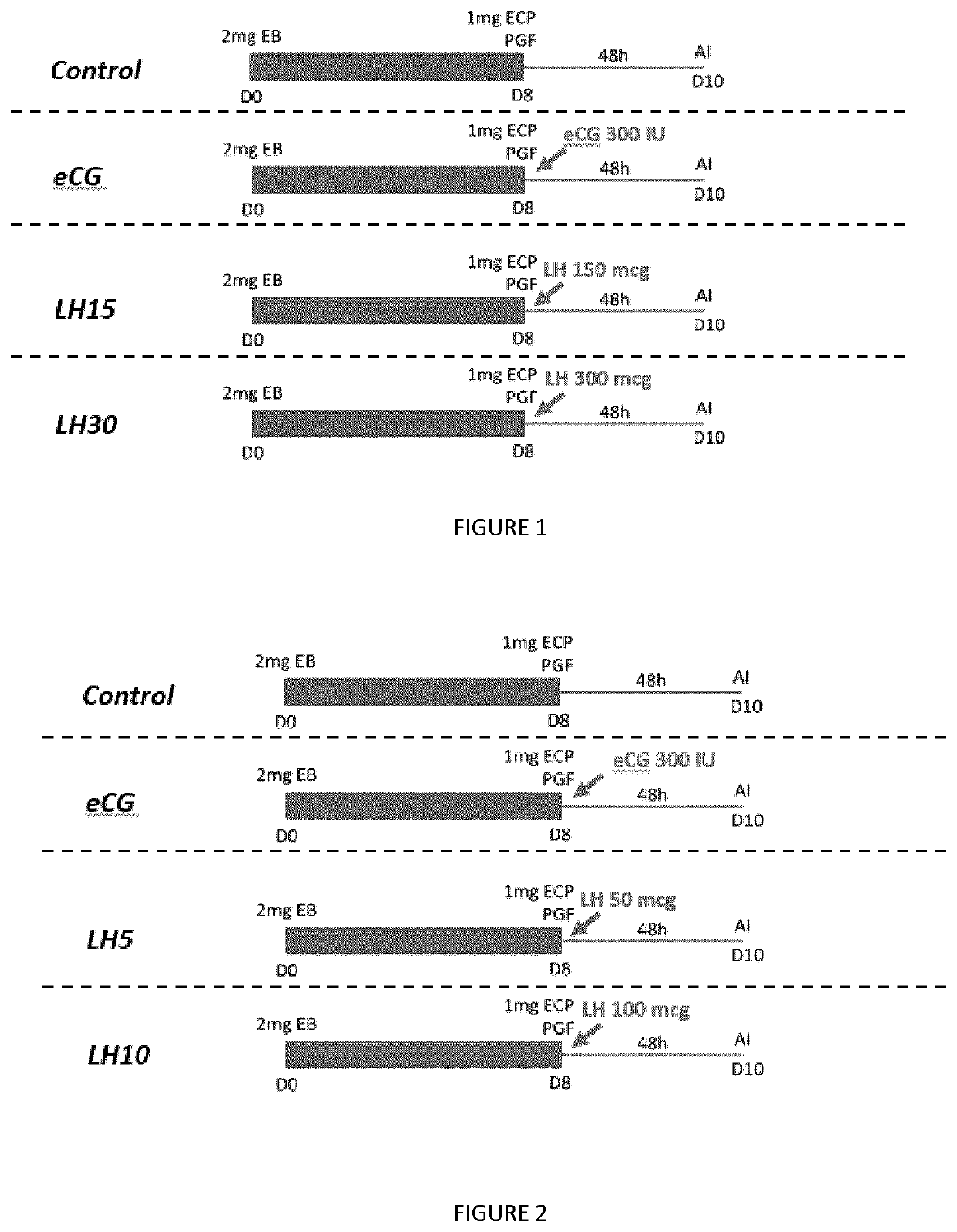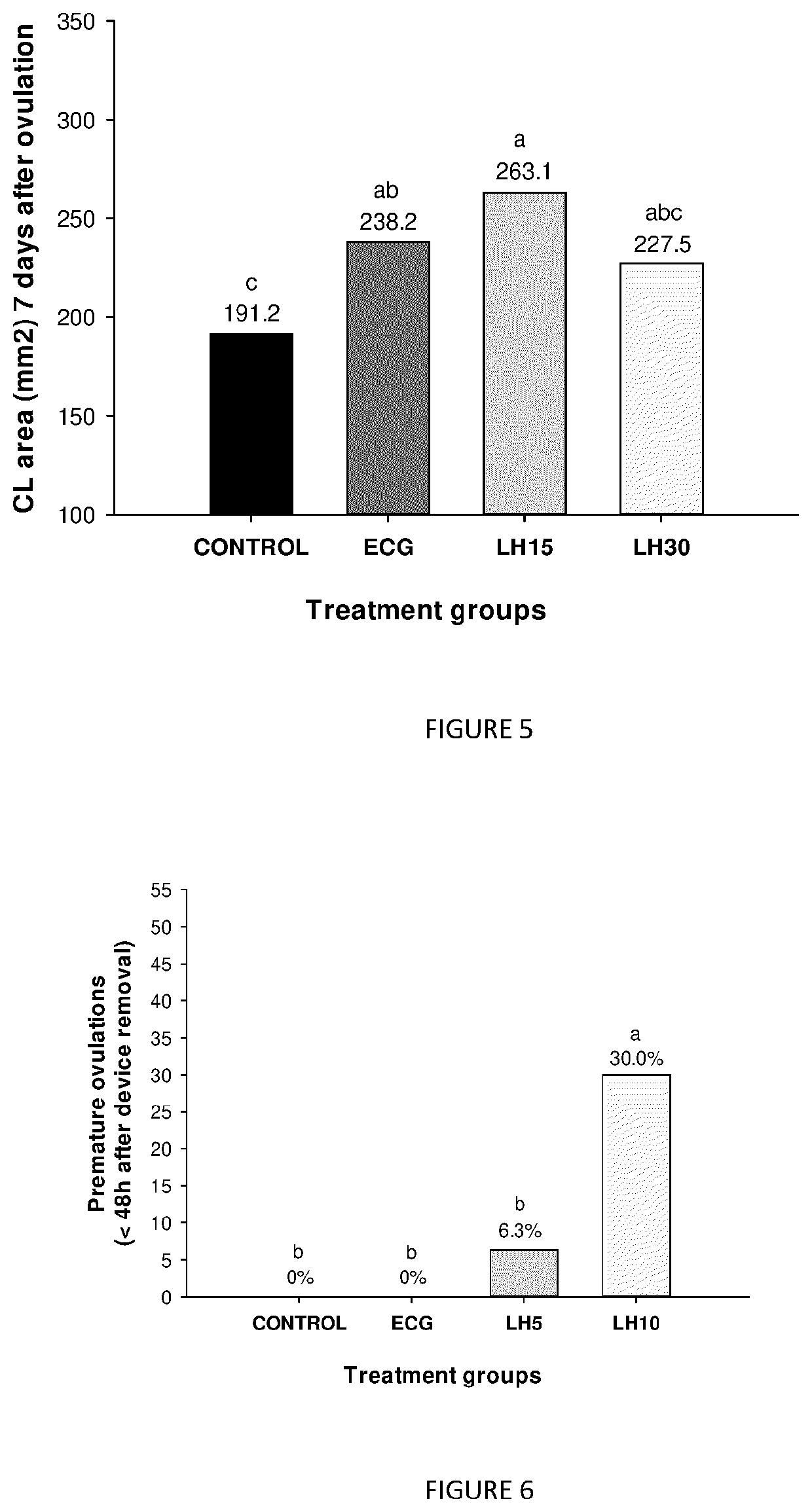Compositions and Methods for increasing Reproduction Performance in Non Human Mammals Using Recombinant Luteinizing Hormone
a technology of luteinizing hormone and non human mammals, which is applied in the field of compositions and methods for increasing the reproduction performance of non human mammals using recombinant luteinizing hormone, can solve the problems of drastic reduction of reproductive hormones, poor estrus detection rate, and inefficient estrus detection, so as to improve the development of corpus luteum, increase the growth rate of follicles, and improve the effect of ovulation results
- Summary
- Abstract
- Description
- Claims
- Application Information
AI Technical Summary
Benefits of technology
Problems solved by technology
Method used
Image
Examples
examples
Methods
[0103]A series of several studies were performed by implementing rbLH (in particular rbLH comprising SEQ ID NO: 2) during timed AI protocols in Bos indicus (Nelore) cattle, and comparison with a control or eCG treatment.
study 1
ion of Different Doses of rbLH on Follicle Dynamics.
[0104]Thirty-nine healthy postpartum anestrus Nelore cows, weighing between 400 to 600 kg and ages of 2 to 8 years old were included in the trial. Cows were kept in Brachiaria pastures and were identified by ear tag number. All animals received a progesterone device (P4 device—loaded with 750 mg of natural progesterone) on DO plus 2 mg of estradiol benzoate (EB). Eight days later, at device removal, all animals received a PGF2a (PGF) treatment simultaneously to 1 mg of estradiol cipionate (ECP), and at the same time were randomized (CRD—complete randomized design) to receive one of the 4 treatments, as follows: eCG (300 IU of eCG, n=11); Negative Control (no gonadotropin treatment, n=9); rbLH15 (150 micrograms of rbLH, n=9) and rbLH30 (300 micrograms of rbLH, n=10). This group of cows undergoing the follicular dynamics evaluations received frequent ultrasound scannings (US) throughout the synchronization protocol to evaluate primar...
study 2
ion of a Lower Dose of rbLH on Follicle Dynamics.
[0105]Sixty-two healthy postpartum anestrus Nelore cows, weighing between 400 to 600 kg and ages of 2 to 8 years old were included in the trial. Cows were kept in Brachiaria pastures and were identified by ear tag number. All animals received a progesterone device on DO plus 2 mg of estradiol benzoate (EB). Eight days later, at device removal, all animals received a PGF2a treatment simultaneously to 1 mg of estradiol cypionate (ECP), and at the same time were randomized (CRD—complete randomized design) to receive one of the 4 treatments, as follows: eCG (300 IU of eCG, n=12); Negative Control (no gonadotropin treatment, n=14); rbLH5 (50 micrograms of rbLH, n=16) and rbLH10 (100 micrograms of rbLH, n=20). This group of cows undergoing the follicular dynamics evaluations received frequent ultrasound scanning throughout the synchronization protocol to evaluate primarily the proportion of cows ovulating within 48 h after device removal as...
PUM
| Property | Measurement | Unit |
|---|---|---|
| time | aaaaa | aaaaa |
| time | aaaaa | aaaaa |
| time | aaaaa | aaaaa |
Abstract
Description
Claims
Application Information
 Login to View More
Login to View More - R&D
- Intellectual Property
- Life Sciences
- Materials
- Tech Scout
- Unparalleled Data Quality
- Higher Quality Content
- 60% Fewer Hallucinations
Browse by: Latest US Patents, China's latest patents, Technical Efficacy Thesaurus, Application Domain, Technology Topic, Popular Technical Reports.
© 2025 PatSnap. All rights reserved.Legal|Privacy policy|Modern Slavery Act Transparency Statement|Sitemap|About US| Contact US: help@patsnap.com



